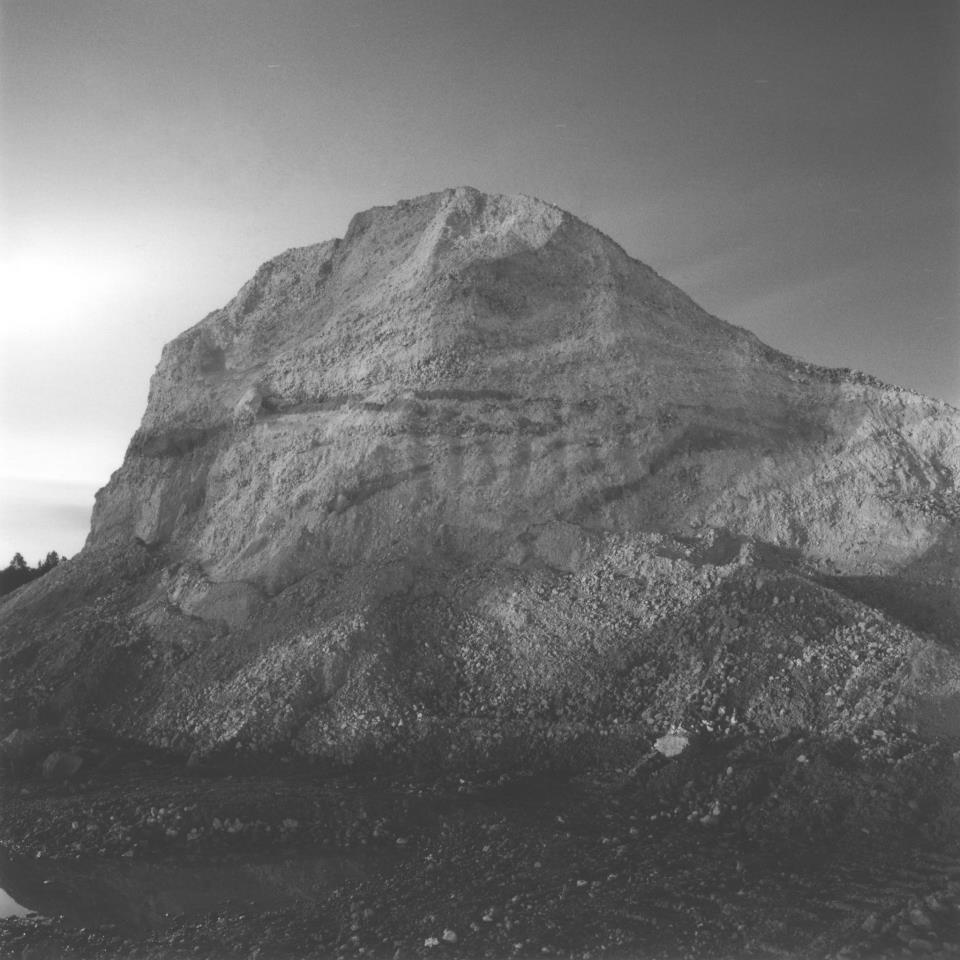Sam Laughlin – Rebuilt History

Sam Laughlin focalizza il suo obiettivo su paesaggi urbani, desolati ed estranianti, ma fa la stessa cosa anche con altri “paesaggi”: quelli linguistici.
Comunicato stampa
Sam Laughlin
Rebuilt History
a cura di Martina Colajanni
Cumuli di pietre innalzati nella Berlino odierna. Cumuli di polvere come somma del pensiero antico e moderno. Queste sono le coordinate di un lavoro essenziale, apparentemente autoreferenziale, ma estremamente estetizzante.
Sam Laughlin focalizza il suo obiettivo su paesaggi urbani, desolati ed estranianti, ma fa la stessa cosa anche con altri “paesaggi”: quelli linguistici. Rispettivamente nella serie GESCHICHTE e PULVER si ritrova costantemente un tentativo di lettura della Storia Sociale, dell’Uomo, delle Idee e di come questi seguano un percorso evolutivo. Percorso che non pretende di essere verità assoluta ma al contrario ha il dovere di essere messo in discussione.
Da qui inizia la Costruzione/Decostruzione della Storia messa in atto da Sam ed intesa come modo per studiare il corso naturale degli eventi rileggendoli, successivamente, in chiave personale. Egli sembra quasi avere incarnato l’idea del Postmoderno che porta in sé il concetto di Mutabilità e di Cambiamento ponendosi in forte contrasto con la concezione involutiva propria della Modernità.
Il percorso di Sam parte dalla polvere ricavata dalla semplice combustione di testi scritti di alcuni tra i dai maggiori pensatori del nostro tempo: Marx, Schopenhauer, Hegel, Nietzsche. Un’azione, questa, che afferma la relatività del loro pensiero, la necessità di una continua interpretazione in rapporto alla contemporaneità e la caducità della parola stessa. A tal proposito, Sam sembra quasi prendere alla lettera il concetto di “Decostruzione” insito nel pensiero di Derrida, il quale avrebbe probabilmente annuito a questo tentativo di “scomposizione”.
Se in PULVER vive il disfacimento, in GESCHICHTE qualcosa si accatasta, si erge verso l’alto. Nella sua imponenza dichiara la sua volontà di essere, di esistere e di radicarsi. Che si tratti di Consapevolezza o di ricerca di un punto fermo non ci è dato saperlo: Samuel Laughlin ci indica lo scheletro di un processo in divenire e della sua avvenuta costruzione.
Le atmosfere della serie GESCHICHTE sono oniriche ed inquietanti, quasi a renderci piccoli al cospetto, mentre in PULVER sentiamo di poter possedere almeno un briciolo di quella polvere.
Un andirivieni costante da ciò che non possediamo più e ciò che possiamo possedere, da quello che sapevamo a quello che potremmo sapere. Una metodologia razionale, la sua, che si esplica in modo asettico, statico e poco propenso alla narrazione.
Molto vicino al racconto per immagini dettato dall’esperienza fotografica tedesca degli anni ’80, e realizzata nell’ambito della Scuola di Dusseldorf, il Britannico Laughlin ne prende la freddezza e l’oggettività compositiva ma non il distacco critico.
GESCHICHTE e PULVER come tesi/antitesi di un unico pensiero che, pur seguendo un tracciato personale, giunge ad avere un risultato definito ed equilibrato. Metaforico e mai letterale.
from 20th of March to the 14th of April
Sam Laughlin
Rebuilt History
Curated by Martina Colajanni
Piles of stone erected in today’s Berlin. Piles of dust like the sum of the ancient and modern mindset.
Those elements work as the coordinates for an essential, apparently self-serving, but extremely aesthetic, photographic work.
Sam Laughlin puts his focus on urban landscapes, on places with abstract and distressing characteristics. But he also uses the same approach when he works on other kinds of landscapes: those of the mind.
In both series, GESCHICHTE and PULVER, it is possible to find an attempt to read the ‘social history’ of men and of ideas, a piece of the evolutionary path of mankind. This path does not want to be an absolute truth but instead wants, and has, to be argued.
From this point begins the ‘Construction/Deconstruction’ of history that Laughlin operates and uses as a medium to study the natural flowing of events. He then translates them, in his personal and original way.
It seems that Laughlin puts into his work an idea of postmodernism that holds in itself the concept of mutation and changing, in opposition to modernity and its regress.
Sam’s path starts from the dust, which originates in the combustion of some of the most influential writings of our time: Marx, Schopenhauer, Hegel and Nietzsche.
The action of burning those books reveals the ‘relativity’ of their thought, and also the need of a continuous interpretation and contextualization of them in relation to our time and with the transience of the ‘word’.
From that assumption it seems that Sam echoes a concept of Deconstruction from Jacques Derrida’s thought. Derrida would probably agree with Laughlin’s attempt to ‘breakdown’ the ‘material’ that holds the concepts.
If in PULVER resides decay, then in GESCHICHTE something is stacked up, growing towards the sky. In GESCHICHTE the process of existence is given by the visualization of a dictated monumentality.
It is not given to us to know if that comes from an awareness of the author, or by research as an anchorage. Sam Laughlin points the finger for us toward the skeleton of a process in progress, as its construction occurs. The atmospheres of GESCHICHTE are fantastic and unsettling, the observer almost feels him/herself too small in front of them. Instead in PULVER the feeling is to be almost able to own an iota of that dust.
In conclusion, in Rebuilt History it is possible to talk about a continuous flow of that which we do not own anymore, against what we can still hold, from what we knew to what we should know.
A rational methodology emerges from Laughlin’s practice and shows itself in a static and objective modus, not so inclined to tell stories.
Close at times to the 1980’s German photographic experience, the British Laughlin takes from it the objectivity and the detachment in his composition, but not the critical detachment.
GESCHICHTE and PULVER as ‘tesi/antitesi’ of a unique concept that, even though following a personal path, reaches an equilibrate and stable result, always metaphorical and never didactic.



